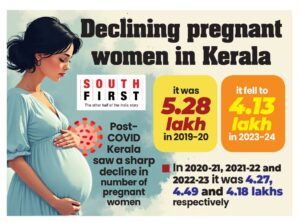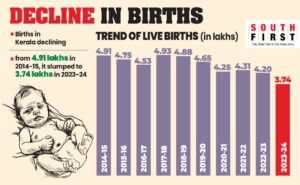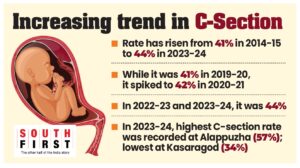Kerala’s demographic profile is its rapidly aging population. From 13% in 2011, the share of those aged 60 and above is projected to touch 23% by 2036.
Published Jun 28, 2025 | 12:00 PM ⚊ Updated Jun 28, 2025 | 12:00 PM

Many women now delay pregnancies in favour of personal and professional growth.
Synopsis: The average age at marriage has risen, and many women now delay pregnancies in favor of personal and professional growth. Adding to this is the steady decline in the female population within the reproductive age group, fuelled by consistently low fertility rates and significant migration.
Kerala, long celebrated as India’s healthiest state with high literacy and low infant and maternal mortality rates (MMR), is now witnessing a silent but significant shift in its health landscape.
The recently released 2023-24 Health Report reveals sharp demographic and reproductive health trends, from declining pregnancies to rising caesarian-section rates and a burgeoning elderly population, signalling a new set of challenges for the state’s famed healthcare model.
One of the most striking findings is the steep decline in the number of pregnant women registering in Kerala. From 5.28 lakh in 2019-20, the number dropped to 4.27 lakh in 2020-21, and further to 4.13 lakh in 2023-24.

This drop aligns with national fertility trends but has been exacerbated in Kerala by pandemic-related uncertainties and lifestyle changes.
Among the 4.14 lakh registered pregnancies in 2023-24, there were concerning outliers: 15 pregnancies among girls below 15 years, and 256 cases in women above 49 years.
The majority of pregnancies remained within the 19-49 years age group, but these figures hint at persistent gaps in awareness and access to family planning services.
A senior health official explained that the sharp drop in pregnancies mirrors a broader societal shift in Kerala. “We’re witnessing a clear trend towards smaller families, driven by higher education levels, evolving career priorities, and changing lifestyle preferences,” the official noted.
Couples today are increasingly choosing to have fewer or no children, naturally bringing down pregnancy rates, the official said.
The average age at marriage has risen, and many women now delay pregnancies in favour of personal and professional growth. Adding to this is the steady decline in the female population within the reproductive age group (15–49 years), fuelled by consistently low fertility rates and significant migration.

“Many women in this age group are moving abroad for education and work, choosing to settle and start families outside Kerala. This too has contributed to the local decline in pregnancies,” the official added.
At the same time, it is being pointed out that the Covid-19 pandemic had its own devastating impact.
Health officials cited that Kerala had reported the deaths of pregnant women due to the virus, with severe complications like Covid pneumonia, cytokine storms, and premature births becoming alarmingly common. Fearing such risks, many couples chose to postpone or entirely avoid pregnancies during this period.
Economic distress following the pandemic further deepened the crisis. Job losses and falling household incomes, especially in families with pregnant or postpartum women, pushed many into poverty.
“In such uncertain times, economic pressures may also have played a major role in discouraging couples from starting or expanding their families,” the official added.
As part of the state’s Vilarchayil Ninnum Valarchayilekku (From anaemia to growth – VIVA) campaign, widespread hemoglobin testing was conducted, revealing that 27% of pregnant women were anaemic in 2023-24.
The most cases were reported from Palakkad. Of the 5,999 pregnant women tested, 2,673 were found to be anaemic. Wayanad follows Palakkad with 3,374 cases of anaemia among 8,020 pregnant women.
This is a worrying indicator in a state otherwise known for robust maternal care, underlining the need for targeted nutritional interventions.
Health officials pointed out that despite Kerala’s reputation for strong maternal healthcare, the persistence of anaemia among 27% of pregnant women reflects hidden nutritional and lifestyle gaps.
“Factors include changing food habits, reduced consumption of iron-rich traditional diets, early pregnancies in some pockets, and poor adherence to iron supplementation. Additionally, high rates of gestational diabetes and frequent caesarean deliveries in the state complicate maternal nutrition, making targeted interventions essential,” said a health official.
The report highlights a rising trend in abortions over the past decade, with induced abortions increasing at a steeper rate than spontaneous ones.
There are two types of abortions: Spontaneous and induced. A spontaneous abortion is where a pregnancy ends on its own — that is, without medical intervention — before 20 weeks of pregnancy. An induced abortion is where a pregnancy is ended intentionally. Induced abortion is often simply called “abortion.” Spontaneous abortion is another term for miscarriage.
In 2023-24, of the 30,037 abortions, 20,179 were induced abortions. Of them, 14,825 happened in private health care institutions. In 2022-23, the total abortions reported were 25,686, including 14,519 induced abortions. As many as 10,869 induced abortions were at private healthcare institutions.
“The rising trend in abortions — particularly induced abortions — in Kerala over the past decade can be attributed to multiple social, economic, and healthcare-related factors,” said an official with reproductive medicine wing. “Improved access to reproductive healthcare services, including safe abortion facilities and better reporting mechanisms, has made it easier for women to seek medical termination of pregnancies.”
Additionally, the official said, changing social attitudes, delayed marriages, career priorities, and economic insecurities have contributed to unintended or unplanned pregnancies, leading to an increase in induced abortions. The rising awareness about legal rights to abortion have also played a role.
At the same time, gaps in consistent contraceptive use, limited comprehensive sex education, and concerns over social stigma in cases of out-of-wedlock or unwanted pregnancies is also being cited for this upward trend.
Compounding this, the utilisation of family planning services — especially permanent methods — has sharply declined. Over the last 10 years, there’s been a 64% dip in non-scalpel vasectomies (NSV), a 38% decline in laparoscopic sterilisations, and a 47% reduction in postpartum sterilisations.
A fall in non-scalpel vasectomy (NSV, an invasive surgical procedure for male sterilisation) has been reported. In 2022-23, 634 NSVs were performed in the state. However, in 2023-24, it was 457. The same is the case with laparoscopic sterilisation (a permanent method of birth control for women). In 2022-23 it was 10,592. However, in 2023-24, it became 10,397.
In the case of postpartum sterilisation (a surgical procedure to permanently prevent future pregnancies after childbirth), 45,305 women undergo the same in 2022-23. However, it was 36,394 in 2023-24.
Experts attribute this trend to changing social preferences, delayed marriages, and a growing reliance on temporary contraceptive methods.
Kerala continues to grapple with high caesarean-section rates in both public and private sectors.

The C-section rate has climbed from 41% in 2014-15 to 44% in 2023-24. This is well above the World Health Organization’s recommended threshold of 15%, raising concerns about the medicalization of childbirth and its long-term health implications.
It is being pointed out that persistently high C-section rates in Kerala reflect a complex interplay of medical, institutional, and societal factors.
In the private sector, financial incentives and the convenience of scheduling deliveries often drive the preference for surgical births.
Meanwhile, in public hospitals, overburdened infrastructure, staff shortages, and medico-legal concerns prompt clinicians to opt for C-sections as a safer, faster alternative to prolonged labour management. Additionally, rising maternal age, increased prevalence of lifestyle diseases like hypertension and diabetes, and heightened anxiety among expectant families contribute to a growing demand for caesareans.
Together, these factors have normalised surgical deliveries, sidelining natural birth practices and fueling a cycle of medicalised childbirth in the state.
Kerala’s official Maternal Mortality Ratio (MMR), as per the latest Sample Registration System (2020-22), has touched an all-time low of 18 per one lakh live births.
However, state health officials caution against complacency, noting that Covid-19 had claimed 97 pregnant women during the survey period.
The report highlights that in 2014-15, 158 maternal deaths were reported. It peaked to 220 in 2021-22, as it has been mentioned that of them 97 are due to covid pneumonia. It fell to 118 in 2021-22 and in 2023-24 it was 119. However, in 2021-22 and 2023-24, of the total maternal deaths, 13 deaths each were maternal suicides.
On the infant front, out of 2,032 deaths reported in 2023-24, 18% occurred within 24 hours, and 63% within the neonatal period (first 28 days) — highlighting persistent challenges in newborn care.
The proportion of preterm births surged from 1.4% in 2017-18 to 7.21% in 2023-24.
Additionally, the share of newborns weighing less than 2.5 kg has risen from 11% in 2014-15 to 14% in 2023-24. These trends signal an increasing burden of neonatal complications and long-term developmental risks.
While Kerala continues to lead in immunisation, coverage has slightly declined from 95% in 2021-22 to 94% in 2023-24. Districts like Malappuram (86%) and Kozhikode (92%) have registered noticeable drops, necessitating renewed outreach.
Complicating Kerala’s demographic profile is its rapidly aging population. From 13% in 2011, the share of those aged 60 and above is projected to touch 23% by 2036. With a rising median age — set to reach 39.6 years by 2036 — the state’s health priorities are gradually shifting towards geriatric care and chronic disease management.
Kerala’s latest health report underscores a healthcare system at a demographic crossroads — dealing with the dual burden of falling fertility rates and an aging population, even as maternal and neonatal challenges persist.
For a state once hailed as India’s health success story, recalibrating its reproductive, child, and elderly health strategies is not just timely — it’s imperative.
(Edited by Majnu Babu).
